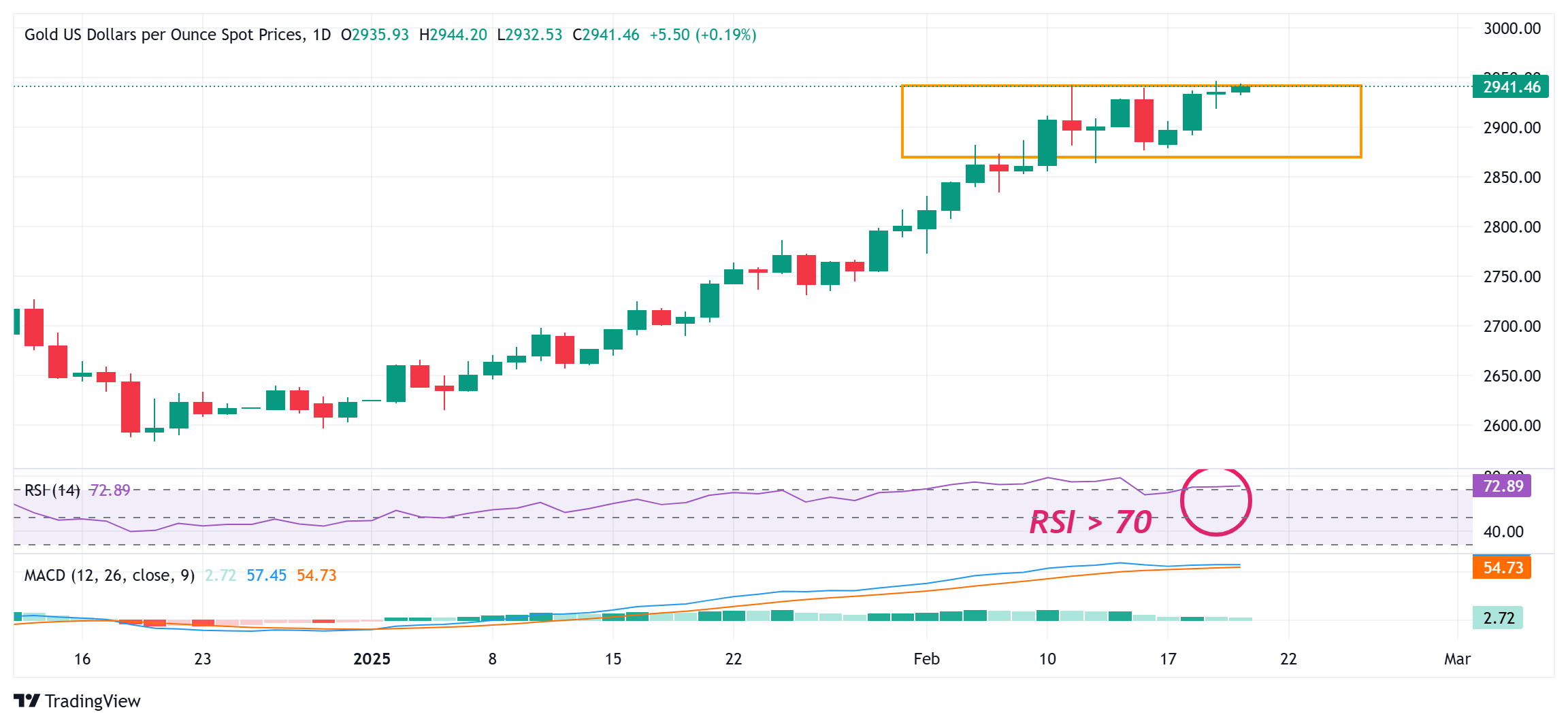Gold price trades with positive bias near record high on Trump’s tariff threats

Gold price retains its bullish bias amid worries about Trump’s tariffs and a global trade war.
Sliding US bond yields weigh on the USD and lend additional support to the precious metal.
The Fed’s hawkish outlook could cap the XAU/USD pair amid slightly overbought conditions.
Gold price (XAU/USD) attracts fresh buyers during the Asian session on Thursday and remains close to the record high touched the previous day. US President Donald Trump's fresh threat to impose tariffs on imported goods sparks concerns about a global trade war and continues to underpin demand for the safe-haven bullion. Meanwhile, flight to safety triggers a fresh leg down in the US Treasury bond yields and turns out to be another factor benefiting the non-yielding yellow metal.
Apart from this, the emergence of some US Dollar (USD) selling lends additional support to the Gold price. That said, hawkish FOMC meeting minutes released on Wednesday reaffirmed expectations for an extended pause on rates by the Federal Reserve (Fed). This could act as a tailwind for the US bond yields and the Greenback, which, in turn, might hold back bullish traders from placing fresh bets around the XAU/USD amid slightly overbought conditions on the daily chart.
Gold price continues to attract safe-haven flows amid rising global trade tensions
US President Donald Trump said on Wednesday that he will announce heavy tariffs on a number of products next month or even sooner, raising the risk of a further escalation of trade tensions and underpinning the safe-haven Gold price.
US Commerce Secretary Howard Lutnick said in a Fox News interview that Trump's goal is to abolish the Internal Revenue Service and let all the outsiders pay. Meanwhile, Trump said that a new trade deal with China is possible.
The US Dollar struggles to capitalize on its modest recovery gains registered over the past two days amid a fresh leg down in the US Treasury bond yields and turns out to be another factor lending additional support to the precious metal.
Minutes from the last FOMC policy meeting held in January released on Wednesday revealed officials noted a high degree of uncertainty that requires the central bank to take a careful approach in considering any further interest rate cuts.
Fed Vice Chairman Philip Jefferson said that the US economic performance has been quite strong, the US labor market is solid, inflation has eased but is still elevated, and the path back to the 2% inflation target could be bumpy.
Chicago Fed President Austan Goolsbee said that inflation has decreased but it is still excessive and once inflation falls, rates can fall more. This, however, fails to impress the USD bulls or influence the non-yielding yellow metal.
Thursday's US economic docket features the usual Weekly Initial Jobless Claims and the Philly Fed Manufacturing Index. This, along with speeches by influential FOMC members, could drive the USD and the XAU/USD pair.
The market focus will then shift to the release of flash global PMIs on Friday, which should provide a fresh insight into the global economic health and provide some meaningful impetus to the safe-haven commodity.
Gold price could consolidate further before the next leg up; bullish bias remains
From a technical perspective, the daily Relative Strength Index (RSI) is holding above the 70 mark and warrants some caution for bullish traders. This, in turn, suggests that the Gold price is more likely to extend over a one-week-old range-bound price action. Nevertheless, the near-term bias remains tilted firmly in favor of bullish traders and suggests that the path of least resistance for the XAU/USD pair remains to the upside. A sustained strength beyond the $2,945-2,950 area will mark a fresh breakout through a short-term range and a consolidation phase. This would set the stage for an extension of a well-established uptrend witnessed over the past two months or so.
Meanwhile, any corrective pullback below the $2,928 immediate support could be seen as a buying opportunity near the $2,918 region, or the overnight swing low, and remain limited near the $2,900 mark. This is followed by the $2,880 horizontal support, which if broken decisively could drag the Gold price to the $2,860-2,855 area en route to the $2,834 zone. Some follow-through selling should pave the way for a fall toward the $2,815 region before the XAU/USD pair eventually drops to the $2,800 mark and the next relevant support near the $2,785-2,784 area.
Gold FAQs
Gold has played a key role in human’s history as it has been widely used as a store of value and medium of exchange. Currently, apart from its shine and usage for jewelry, the precious metal is widely seen as a safe-haven asset, meaning that it is considered a good investment during turbulent times. Gold is also widely seen as a hedge against inflation and against depreciating currencies as it doesn’t rely on any specific issuer or government.
Central banks are the biggest Gold holders. In their aim to support their currencies in turbulent times, central banks tend to diversify their reserves and buy Gold to improve the perceived strength of the economy and the currency. High Gold reserves can be a source of trust for a country’s solvency. Central banks added 1,136 tonnes of Gold worth around $70 billion to their reserves in 2022, according to data from the World Gold Council. This is the highest yearly purchase since records began. Central banks from emerging economies such as China, India and Turkey are quickly increasing their Gold reserves.
Gold has an inverse correlation with the US Dollar and US Treasuries, which are both major reserve and safe-haven assets. When the Dollar depreciates, Gold tends to rise, enabling investors and central banks to diversify their assets in turbulent times. Gold is also inversely correlated with risk assets. A rally in the stock market tends to weaken Gold price, while sell-offs in riskier markets tend to favor the precious metal.
The price can move due to a wide range of factors. Geopolitical instability or fears of a deep recession can quickly make Gold price escalate due to its safe-haven status. As a yield-less asset, Gold tends to rise with lower interest rates, while higher cost of money usually weighs down on the yellow metal. Still, most moves depend on how the US Dollar (USD) behaves as the asset is priced in dollars (XAU/USD). A strong Dollar tends to keep the price of Gold controlled, whereas a weaker Dollar is likely to push Gold prices up.
* The content presented above, whether from a third party or not, is considered as general advice only. This article should not be construed as containing investment advice, investment recommendations, an offer of or solicitation for any transactions in financial instruments.



